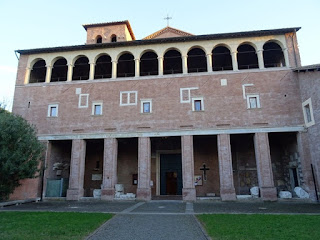San
Saba is an ancient basilica church in an area close to the ancient Aurelian
Walls next to the Aventine Hill. Saint
Silvia, the mother of Pope Gregory I, had her home at the site. Born into a distinguished
Sicilian family in 519 CE, Silvia married Gordianus, the ecclesiastical head of
the Roman Catholic region of Rome. She
was noted for her extraordinary beauty, piety and graciousness. After the death of her husband around 573 CE,
Silvia had a chapel built in her home and devoted herself entirely to a life of
pious devotion in what she called a new cell by the gate of the Paul.
The
veneration of Saint Silvia began soon after her death in 592 CE. Her son, Pope Gregory I built a monastery
dedicated to Saint Andreas, an affiliate of the monastery he founded at San
Gregorio al Celio on the site. In 645 CE
fugitive monks from the monastery of San Saba fleeing persecution in Palestine
were given the monastery which they re-dedicated to Saint Sabas, a
Cappadocian-Syrian monk and saint who died in Palestine in 532 CE.
The
abbots of San Saba played important diplomatic roles in fostering right
relations between the Churches at Rome and Byzantium and represented the Pope
at several church councils held in Constantinople. Their influence came to an
end in the 8th century when the Antipope Constantine II was held prisoner at
San Saba and killed by the Lombards.
The
monastery has been rebuilt and changed hands many times over the
centuries. It was given to the
Benedictine monks of Monte Cassino in the 10th century, to the Cluniac monks in
the 12th century, to the Cistercians in 1503 and to the Jesuits in 1573 who
used it for their German and Hungarian seminary.
The
crypt under the altar is said to hold the relics of San Saba while Saint
Silvia’s relics are interred in a tomb beneath the oratory dedicated monastery
of San Gregorio al Celio on the Caelian Hill.
Next to San Saba is a convent of nuns and a homeless shelter run by the
Missionaries of Charity founded by Blessed Mother Teresa of Calcutta.
